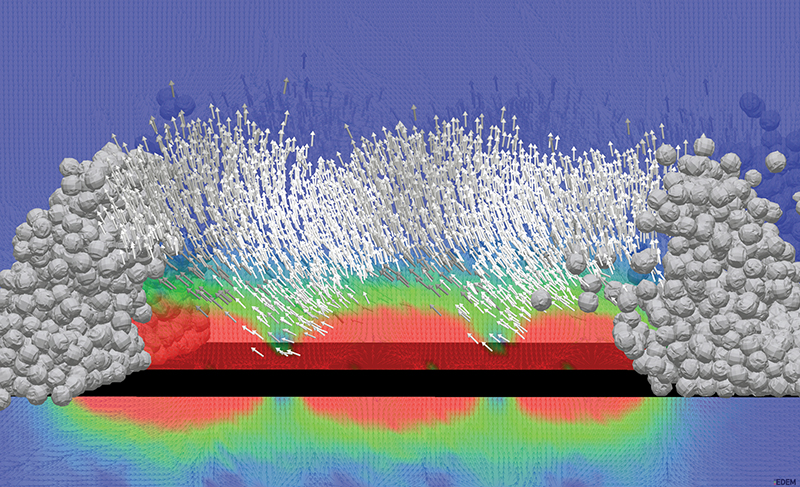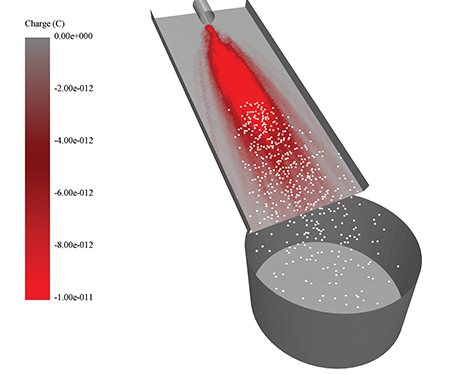
Computer Models Simulate Fine Particle Dispersion
Originating Technology/NASA Contribution
Getting to the Moon is, to say the least, challenging. Being on the Moon, though, is no picnic either. In addition to the obvious life support and temperature control concerns, astronauts must contend with another obstacle: the Moon’s surface. This surface is covered with sharp, abrasive dust, lunar soil, and rock, called regolith, which can pose a variety of problems for astronauts and their equipment.
When the Apollo astronauts touched down on the lunar surface, their visibility was severely limited due to dust being kicked up, a phenomenon similar to the “brownout” conditions helicopter pilots experience when flying low in deserts—but coupled with the concern that this abrasive ejecta could damage the lunar module, their only chance of returningsafely. Once on the surface, the astronauts had to contend with the dangers of inhaling or ingesting this fine dust and the possibilities that that their equipment could be damaged or contaminated. These fears were not without warrant; a camera failed when lunar dust entered a drive mechanism during the Apollo 15 mission.
Any return trip to the Moon’s surface, whether it involves humans or robots, will necessitate new methods for predicting the role that lunar regolith will play in the mission, whether it is through surface contamination, excavation, mining, or handling of the dust and lunar rock. Understanding more about the chemical and physical properties of lunar regolith, like how particles interact with each other and with equipment surfaces, or the role of static electricity build-up on dust particles in the lunar environment, is imperative to the development of technologies for removing and preventing dust accumulation and successfully handling lunar regolith.
At NASA’s Kennedy Space Center, Dr. Carlos Calle, founder and director of the Center’s Electrostatics and Surface Physics Laboratory, is currently working on these problems: the electrostatic phenomena of granular and bulk materials as they apply to planetary surfaces.
Through a NASA Seed Fund partnership, Calle was able to partner with industry to enhance commercial modeling software, with mutual benefit to both NASA’s mission needs as well as those of its industry partner.
Partnership
To accomplish some of its technology initiatives, NASA is relying on some innovative methods, such as the Centennial Challenges, a series of prize competitions aimed at spurring inventors and design teams to help NASA design the technologies of the future, with chances to win large cash prizes in the process. The Lunar Lander challenge, for example, is a multiphase competition that challenges teams to build a vertical takeoff vehicle/vertical landing rocket capable of simulating the same characteristics needed for movement between the Moon’s surface and its orbit. Another competition in the Centennial Challenges program is the Lunar Regolith Excavation Challenge, which calls upon teams to build a robot capable of excavating simulated regolith, given weight and power restrictions. Both of these challenges seek to leverage the know-how and creative spirit of amateur and student inventors to benefit NASA’s future mission needs.
An additional innovative method NASA has recently developed for leveraging expertise to meet its needs is the Seed Fund program, which provides funding to address barriers and initiate cost-shared, joint-development partnerships. One such Seed Fund partnership was with DEM Solutions Inc., of Lebanon, New Hampshire. DEM Solutions is a leader in particle dynamics simulation software. Its EDEM software is a computer-aided engineering (CAE) tool that uses state-of-the-art discrete element method (DEM) technology for the simulation and analysis of bulk materials flow in a wide range of particle handling and manufacturing operations. EDEM allows users to import computer-aided drawing models of particles, to obtain accurate representations of their shapes, and to assign physical properties so that the models replicate the behavior of real bulk solid materials.
This software, the most advanced DEM technology commercially available, showed great promise for the study of lunar regolith, but before it could be applied to the NASA work, additional modeling and validation of electrostatic and surface energy adhesion forces, dynamic friction, and particle shape were required. Through the Seed Fund, NASA and DEM Solutions worked together to enhance the existing software to provide more accurate modeling of lunar regolith.
The DEM Solutions Seed Fund proposal provided NASA with both the needed expertise in particle dynamics simulation and a customized, easy-to-use CAE tool for qualifying dust/coating interaction by virtually modeling the behavior of the dust in contact with coatings of electrodynamics screens. EDEM simulations are now routinely used in the development of NASA surface systems dust mitigation technologies designed for dust removal and cleaning of optical and thermal radiator surfaces, connectors, and seals. EDEM virtual prototyping capabilities also streamline the design process for development of systems for In Situ Resource Utilization (ISRU) excavation, traction, material flow, and the electrostatic separation of ilmenite, a mineral found in lunar regolith. “We appreciated this opportunity to expand our software platform to meet NASA needs,” says John Favier, DEM Solutions CEO. “We are always pleased to develop advanced simulation solutions for our customers, but it is especially gratifying to contribute to the NASA mission of space exploration, technology development, and resource utilization.”
The enhancements made during this partnership have been of interest to DEM Solutions’ customers, as well, and the software developments made during the NASA partnership are also finding their way into diverse industry settings.
Product Outcome
These new EDEM capabilities can be applied in many industries unrelated to space exploration and have been adopted by several prominent U.S. companies, including John Deere, Pfizer, and Procter & Gamble.
For John Deere, the NASA and DEM Solutions technology is of interest, as the analysis and modeling of fine, angular, and cohesive particles will enable the company to improve its handling of similar materials on Earth, like sandy or cohesive soils.
In the pharmaceutical realm, the software is able to help manufacturers deal with the fine particles necessary for drug manufacturing, where highly active ingredients, often in fine powder form, need to be contained, maneuvered, and mixed. Accurate modeling of particulate behavior makes this process safer and more efficient. With the newfound, NASA-enabled features, the already one-of-its-kind EDEM software is sure to make future terrestrial and space-related modeling of fine particles a much more accurate and reliable endeavor.
EDEM® is a registered trademark of DEM Solutions Inc.

EDEM simulation investigates how materials such as lunar soils will build up electrical charge while sliding down a chute. With EDEM, NASA can analyze the effects of different chute materials on charge accumulation.

Using EDEM software to simulate lunar dust behavior, NASA investigated how to efficiently clean dust away from equipment on the Moon or Mars—by using the influence of an electrical field to repel the particles. The arrows show dust moving away from a screen that needed cleaning.













